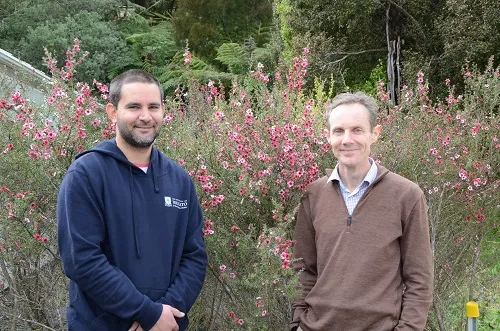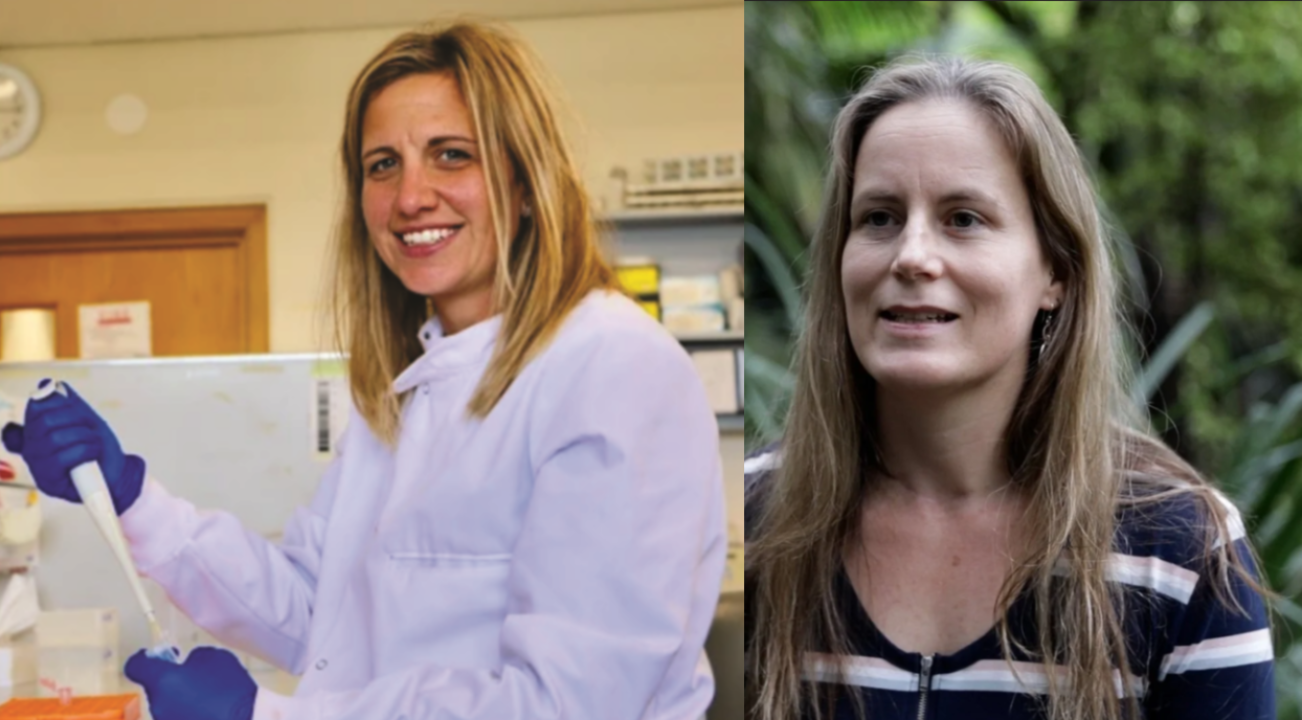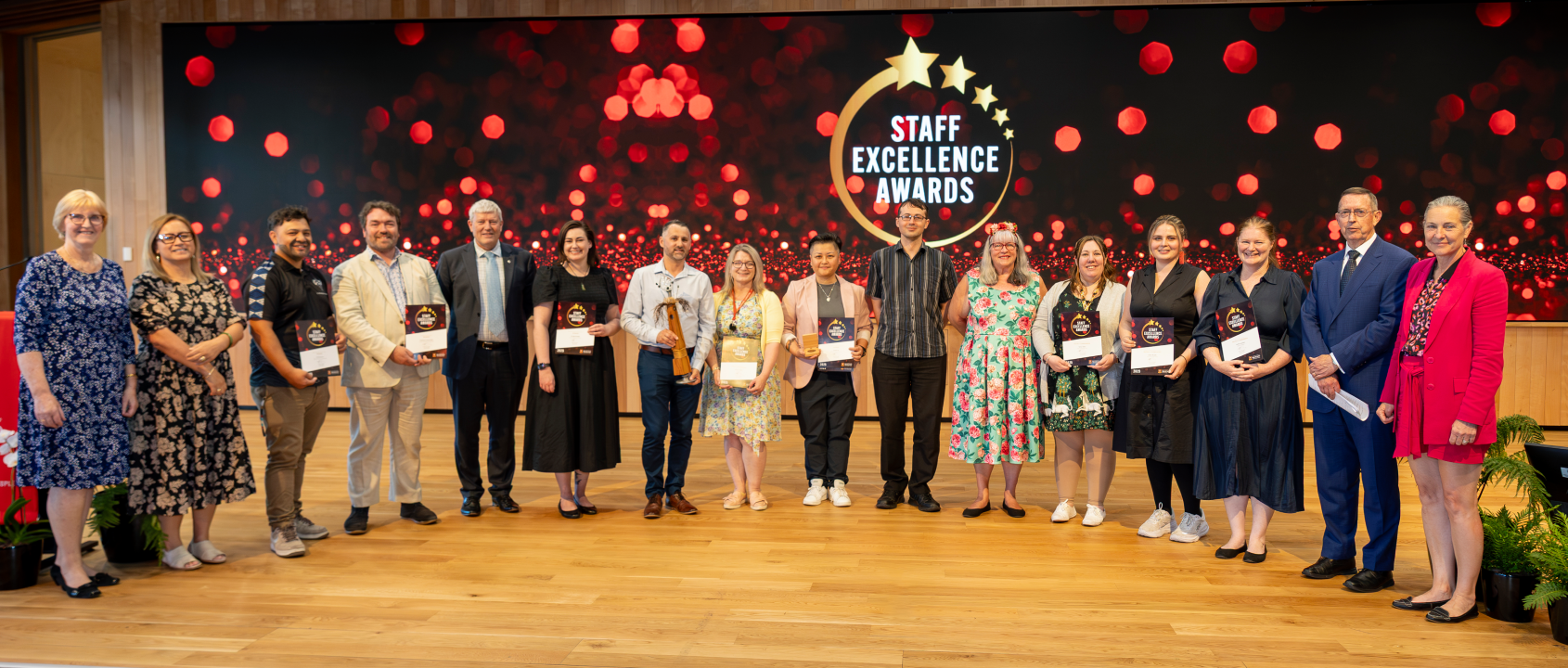The research, published in the international scientific journal New Phytologist, was led by Associate Professor Mike Clearwater, a plant physiologist from Te Aka Mātuatua - School of Science at the University of Waikato.

University of Waikato graduate student Stevie Noe with Associate Professor Mike Clearwater from Te Aka Mātuatua School of Science.
The research investigated why the nectar producing parts of mānuka flowers, known as nectaries, produce the unique ingredients found in the honey. Nectaries are common in many flowering plants, but only mānuka and a small number of related species produce nectar with the active ingredient found in mānuka honey.
The researchers first noticed that in mānuka (Leptospermum scoparium) the nectaries are green, unlike the colourless nectaries of other flowers. They then showed for the first time that nectary photosynthesis – the plant’s process of using sunlight, water and carbon dioxide to create oxygen and sugar – could contribute to nectar production. This contrasts with many other flowers that produce their nectar sugars entirely within their leaves. By studying nectary photosynthesis in mānuka, the research team were able to show that a precursor of the valuable active ingredient found in the honey is produced as a by-product of photosynthesis within the flower.
“Mānuka honey gets its special properties from the nectar of the mānuka flower, a species that is indigenous to New Zealand,” says Associate Professor Clearwater. “The nectar gives this honey its unique bioactive antibacterial and wound-healing properties”.
“This research shows that each mānuka flower has its own ‘solar-powered nectar factory’ that contributes to the production of the antibacterial precursor, the compound dihydroxyacetone (DHA). In the honey, DHA is naturally converted to another compound, methylglyoxal, which gives the honey its antibacterial activity. Photosynthesis in the flower also makes some of the sugar found in the honey, and seems to influence how much nectar is produced. One of the big issues the honey industry faces is unpredictable variation in the yield of mānuka honey and its bioactivity. This research is relevant because it helps us understand how variation in the environment and plant genetics contribute to variation in the honey. For example, fine weather and sunlight on the flowers boosts nectar flow and DHA levels, as well as favouring bee activity.” he says.
Mānuka honey with a high antibacterial activity attracts a premium price. Export earnings from mānuka honey are growing rapidly - in the year ending December 2020, New Zealand exported just over $500 million worth of honey, most of which was mānuka, up from $347 million the year before. China, USA, Japan and the United Kingdom are our biggest export markets.
Associate Professor Clearwater says publication in a prestigious international journal is recognition of the quality of research underway at the University, and is a credit to his team which includes the honey chemist Professor Merilyn Manley-Harris, and graduate students Stevie Noe, Georgia Truman, Jess Murray and Sylvester Obeng-Darko. The research is also part of a larger research collaboration with Māori agribusinesses and landowners, led by Manaaki Whenua Landcare Research and funded by the Ministry of Business Innovation and Employment. The next stage of the research will involve further study of the genetics of nectar production, with the goal of assisting land-owners who wish to select the best mānuka plants for honey production.
“The unique properties of mānuka honey were first discovered at the University of Waikato nearly 40 years ago. Further research at the University then identified the key ingredient in the nectar, but until now we have not known why it is there. It is exciting to be able to contribute to our understanding of such an important taonga species. What’s particularly satisfying is that we’re working closely with our New Zealand honey producers, on research that has a direct application to their work and to future export earnings for New Zealand.”
New Phytologist is a peer-reviewed scientific journal published on behalf of the New Phytologist Foundation by Wiley-Blackwell. It publishes high quality, original research in plant science and was founded in 1902 by botanist Arthur Tansley, who served as editor until 1931.
Read "Nectary photosynthesis contributes to the production of mānuka floral nectar" published paper.



